
In this video, the economic concepts of utility and marginal utility are introduced.
- Subject:
- Economics
- Social and Behavioral Sciences
- Material Type:
- Lesson
- Provider:
- Khan Academy
- Provider Set:
- Khan Academy
- Author:
- Sal Khan
- Date Added:
- 08/10/2021

In this video, the economic concepts of utility and marginal utility are introduced.
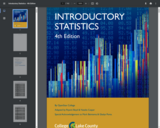
Susan Dean and Barbara Illowsky (Published 2013 by OpenStax College)
Adapted by: College of Lake County Faculty: Riyanti Boyd and Natalia Casper
Revised July 2021
This project was funded by a grant from the College of Lake County Foundation.
Adapted College of Lake County text can be found at:
http://dept.clcillinois.edu/mth/oer/IntroductoryStatistics.pdf
Original text materials for Introductory Statistics by Dean and Illowski 2013
available at: http://cnx.org/content/col11562/latest/.
Original Publication Under the following license:
This work is licensed under the
Creative Commons Attribution-Noncommercial-Share Alike 3.0 unported license.
To view a copy of this license, visit http://creativecommons.org/licenses/by-nc-sa/3.0/
or send a letter to Creative Commons, 171 Second Street, Suite 300, San Francisco,
California, 94105, USA.

Introductory Statistics follows scope and sequence requirements of a one-semester introduction to statistics course and is geared toward students majoring in fields other than math or engineering. The text assumes some knowledge of intermediate algebra and focuses on statistics application over theory. Introductory Statistics includes innovative practical applications that make the text relevant and accessible, as well as collaborative exercises, technology integration problems, and statistics labs.

We hope readers will take away three ideas from this book in addition to forming a foundation of statistical thinking and methods.
(1) Statistics is an applied field with a wide range of practical applications.
(2) You don't have to be a math guru to learn from interesting, real data.
(3) Data are messy, and statistical tools are imperfect. However, when you understand the strengths and weaknesses of these tools, you can use them to learn interesting things about the world.

This PowerPoint file contains a Jeopardy-style game suitable for use in an introductory financial accounting class. There are six categories: Short-term assets, Long-term assets, Liabilities, Equity, Financial statements, and Ratio analysis. There is a Daily Double question and a Final Jeopardy question. Audio is included in the PowerPoint file for optional use.

Sociology is the study of social groups, structures, processes, institutions, and events. This course will focus on understanding and applying the sociological perspective, which stresses the importance of the impact of social forces external to the individual in shaping peopleęs lives and experiences. This idea that we are all profoundly affected by the society in which we live is the guiding light of sociology. Sociologists also study the ways in which people, as they interact, shape their social systems. Topics studied will include socialization, social interaction, culture, groups, social structure, deviance, social inequality, social class, race, gender, institutions (political, economic, educational, family, and religious), collective behavior and social change. Students will be asked to learn the basic concepts, theories, and perspectives of sociology, to see how these operate in terms of social processes, structures, and events, and to apply this knowledge to better understand the social world.

Dr. O discusses the various types of muscle contractions, emphasizing that not all contractions result in visible movement. The main types of muscle contractions mentioned are isometric, isotonic (which can be further divided into concentric and eccentric), and isokinetic (though he briefly touches on this, noting it requires specialized equipment). Isometric contractions involve no change in muscle length and no movement; for example, the postural muscles we use to stand or sit. Isotonic contractions result in a change in muscle length and include concentric contractions (muscles contract and get shorter, like when lifting a weight) and eccentric contractions (muscles contract and get longer, like when lowering a weight). Dr. O also mentions that eccentric contractions, while useful in muscle development, can cause muscle damage due to the nature of the contraction.

This course prepares students who are unfamiliar with computer applications to use the Internet for research and communication. Microsoft Office® programs will be used to prepare business letters, newsletters and spreadsheets. Focus will be on formatting and content. Please note that all course materials and content are provided in the IMS Common Cartridge (IMSCC) format. The content can be accessed by opening the IMSCC file using your organization's Learning Management System application (these include Blackboard, D2L, Canvas etc.). Additional information about accessing Common Cartridge files can be found on the IMS Global Web site: http://www.imsglobal.org/cc. Future plans for the Skills Commons Web site include a feature that will allow users to view and download course content that is provided in the IMSCC format. Please refer to the "Enabling Others to Reuse Your Materials” page for more information: http://support.taaccct.org/enabling-reuse/. Each IGEN Consortium college has established an Industry Advisory Group as part ...

" This course is an introduction to labor economics with an emphasis on applied microeconomic theory and empirical analysis. We are especially interested in the link between research and public policy. Topics to be covered include: labor supply and demand, taxes and transfers, minimum wages, immigration, human capital, education production, inequality, discrimination, unions and strikes, and unemployment."
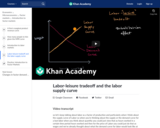
The basis of the labor supply curve is the tradeoff of labor and leisure. When wages increase, the opportunity cost of leisure increases and people supply more labor. Interestingly, this is not always the case! At higher wages, the marginal benefit of higher wages becomes lower and when it drops below the marginal benefit of leisure, people switch to more leisure and less labor. This leads to the rather unusual looking backward bending labor supply curve.

The law of demand states that as the price of a good decreases, the quantity demanded of that good increases. In other words, the law of demand states that the demand curve, as a function of price and quantity, is always downward sloping. In this video, we explore the law of demand and its implications for graphing demand curves. Created by Sal Khan.

In this video we explore the law of supply which states that quantity supplied increases as price increases. We use a supply schedule to describe the quantities a seller is willing to sell at different prices, and then translate the supply schedule into a supply curve that illustrates the law of supply. Created by Sal Khan.

"Rising textbook costs are a potential barrier to student progression and retention. Therefore, a group of faculty in the department of Mathematics at Augusta University has decided to adopt an open textbook for use in an Elementary Statistics course.
We have developed a set of materials to accompany the OpenStax Introductory Statistics textbook by Illowsky and Dean including lecture/study notes and projects.
These materials are meant as a supplement for teachers and learners who are using the OpenStax Introductory Statistics textbook by Illowsky and Dean. These materials also incorporate the use of other technologies (R and Excel) in an open statistics course for students and instructors who wish to use technologies other than the TI-83/84 graphing calcuator."

Thomas Hobbes's Leviathan is an important primary text. Hobbes's social contract theory relies on a thought experiment involving a hypothetical state of nature in which there are no rules or laws. He argues that life in the state of nature would be "solitary, poor, nasty, brutish, and short," and that accordingly we should renounce most of our rights and freedoms by giving them to a powerful sovereign, who will in turn protect us from foreign threat and from one another.

This is a first draft of a free (as in speech, not as in beer, [Sta02]) (although it is free as in beer as well) textbook for a one-semester, undergraduate statistics course. It was used for Math 156 at Colorado State University–Pueblo in the spring semester of 2017.

In this video we explore the long run average total cost curve and how average costs vary when all inputs can be adjusted.
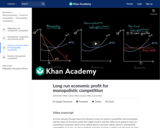
In this video, we compare and contrast the long run outcomes for monopolistic competition, monopolies, and perfect competition.
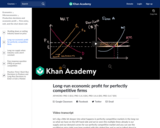
A firm in a perfectly competitive market might be able to earn economic profit in the short run, but not in the long run. Learn about the process that brings a firm to normal economic profits in this video.
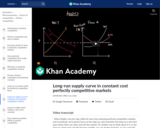
A constant cost industry is an industry where each firm's costs aren't impacted by the entry or exit of new firms. Learn about the difference between the short run market supply curve and the long run market supply curve for perfectly competitive firms in constant cost industries in this video.

In some industries, the number of firms in the market has an impact on the costs that firms face. For example, when firms have to compete with each other over resources, firms' costs increase as more firms enter the market. But in other industries, more firms actually lower costs for firms. Learn about the implications of each of these situations on the long-run supply curve in an industry.